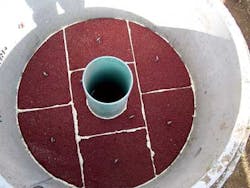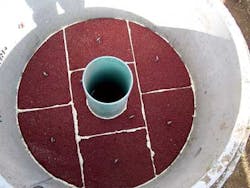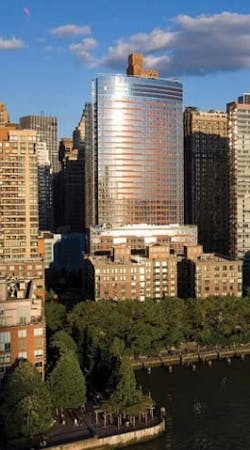ecoLogs
EPA proposes standards to protect Florida’s waters
WASHINGTON, DC — The EPA is proposing water quality standards to protect Florida’s waters. The standards would set a series of numeric limits on the amount of phosphorus and nitrogen that would be allowed in the state’s lakes, rivers, streams, springs and canals. This marks the first time EPA has proposed numeric limits for any one state.
The proposed action also introduces and seeks comment on a new regulatory process for setting standards in a manner that drives water quality improvements in already impaired waters. The proposed new regulatory provision, called restoration standards, would be specific to nutrients in the state of Florida.
EPA is accepting public comment on the proposed standards and will hold three public hearings in Florida during the month of February. More on the proposed rule and public hearings is available at www.epa.gov/waterscience/standards/rules/florida/.
MACTEC wins contract for Florida stormwater project
WEST PALM BEACH, FL — MACTEC has signed a $2.5 million contract with South Florida Water Management District (SFWMD) to provide construction management services for a major stormwater project there.
MACTEC will also provide construction inspection, materials testing and verification surveying services for the Lakeside Ranch Stormwater Treatment Area North (STA), located in western Martin and adjacent Okeechobee Counties.
The project will encompass 2,700 acres and include a 3-cell STA, distribution/outlet canals and water control structures. The Lakeside Ranch North STA is expected to provide additional treatment for nutrient-laden waters flowing into the Everglades.
Spencer, IA, gets grant for combined sewer separation project
KANSAS CITY, KS — EPA has awarded $146,000 to Spencer, IA, for ongoing planning and design for a multi-phased combined sewer separation project.
In 2008, the City of Spencer signed a consent order with EPA to reduce or eliminate its combined sewer overflows into the Little Sioux River. The city has retained an engineer to perform planning and design of this project that will meet requirements outlined in the EPA consent order.
EPA to initiate rulemaking on stormwater, CAFOs to reduce water pollution
WASHINGTON, DC — EPA is initiating new federal rulemaking on stormwater and concentrated animal feeding operations (CAFOs) to reduce water pollution in the Chesapeake Bay watershed. This is intended to complement ongoing work by EPA and the states to strengthen regulatory controls on major sources of pollutants consistent with shared commitments to implement the Chesapeake Bay Total Maximum Daily Load.
To assist the six states in the Bay watershed and the District of Columbia with permitting, enforcement and other key regulatory activities, EPA will provide an additional $11.2 million for 2010, which more than doubles 2009 funding levels.
City gets $1.3M in for ‘green’ improvements to protect Pacific Ocean
SAN FRANCISCO, CA — The City of Hermosa Beach, CA, has received nearly $1.3 million in federal Recovery Act funding from the U.S. EPA and State Water Resources Control Board to support improved stormwater management through a ‘Greenstreet’ retrofit of Pier Avenue.
The Pier Avenue Improvement project includes a new storm drain system designed to address existing flooding problems and reduce stormwater pollution to the nearby beach. The system will incorporate an innovative infiltration system that will retain stormwater runoff, irrigate new drought-tolerant landscaping and divert runoff that would otherwise end up in the ocean.
In Southern California, urban stormwater runoff is the leading cause of pollution in coastal waters. In Hermosa, beaches are considered impaired because they exceed the state’s bacteria standard. This retrofit project is designed to reduce discharges of bacteria-laden stormwater. It also includes features to control trash that would otherwise be discharged to the Ocean.
Baker recognized for river restoration, parks project in North Carolina
CARY, NC — The American Council of Engineering Companies of North Carolina (ACEC-NC) selected Michael Baker Engineering as the 2010 Engineering Excellence Grand Award winner in the Environmental Category for the Ararat River Restoration, Greenway, and Parks Project.
The project restored approximately 3.5 miles of the Ararat River, constructed a 2.5-mile riverside greenway, refurbished one park and constructed two additional parks.
In addition to the environmental benefits of a restored stream, the project provides educational, recreational, and aesthetic benefits to area visitors and residents, and is designed to encourage area youth to have a more active lifestyle and further expand the City’s stated goal of becoming an ecotourism destination.
New Jersey DEP approves use of Hydro International filter in stormwater treatment projects
PORTLAND, ME — The New Jersey Department of Environmental Protection (NJDEP) has approved the use of Hydro International’s Hydro Up-Flo® Filter in New Jersey stormwater treatment projects.
The Up-Flo Filter is a high-rate stormwater filtration technology that removes trash, sediments, nutrients, metals and hydrocarbons from stormwater runoff.
The approval followed verification by the New Jersey Corporation for Advanced Technology (NJCAT) of the filter’s performance capabilities in a rigorous series of tests. For development and redevelopment construction projects in the State of New Jersey, the Up-Flo Filter will now be used on inflow drainage areas of up to 1.8 acres for a 6-module configuration. This represents a maximum drainage area of 0.3 acres per filter module. The 6-module configuration fits into a standard four-foot concrete manhole.
MWH Soft to assist Los Angeles in water-saving efforts
BROOMFIELD, CO — The Los Angeles Department of Water and Power (LADWP) Recycled Water Division will implement MWH Soft’s InfoWater Suite software to help meet the city’s pledge of meeting water demands through conservation and recycling.
Since LADWP officials unveiled the “Water Supply Action Plan” in 2008, the city’s total use of recycled water is up to 7,200 acre-feet per year. The water is used for irrigation and industrial purposes, and for environmental uses, including serving as a barrier to seawater intrusion.
All recycled wastewater in Los Angeles undergoes treatment and disinfection to the tertiary level and meets stringent water quality standards set by the California State Department of Public Health. The treated water travels to the end user through a network of pipes that are painted purple to differentiate them from those that carry potable water.
Nationwide partnership aims to protect water resources
WASHINGTON, DC — The U.S. Army Corps of Engineers and The Conservation Fund have signed a memorandum of understanding announcing a partnership that will promote enhanced conservation and balanced management of the nation’s water resources and sustainable development in adjacent communities.
Through this partnership, USACE and The Conservation Fund will look to conserve freshwater, estuarine and coastal water resources and the native plant and animal communities associated with them; promote greater use of green infrastructure, non-structural approaches to flood protection and stormwater mitigation; promote innovative, effective responses to climate change that will maintain healthy water resources and associated natural communities; encourage water management approaches that benefit both natural and human communities; and develop understanding and skills at all levels in public and private sectors needed to preserve the health of the nation’s water resources.
Florida water treatment park recognized for engineering excellence
DENVER, CO — Freedom Park, a water quality park located in Naples, FL, was recognized by Southwest Construction magazine with an Award of Excellence for Best Engineering in the Civil/Public Works category.
CH2M HILL, working for the Collier County Board of County Commissioners, designed the water treatment park to help save the Naples Bay from harmful pollutants and alleviate flooding problems in surrounding areas.
At 50-acres, Freedom Park is a natural water quality treatment facility. The manmade park features an interconnected system of multi-depth ponds, polishing marshes and restored wetlands that function as a natural filtration system similar to the Everglades. Water is cleaned as it travels through both manmade and natural wetlands.
Park amenities include a 5-acre lake and 12 acres of constructed wetlands, with approximately 6,500 feet of trails including 3,500 feet of boardwalk were constructed throughout the park.
Other amenities include a 2,500 square-foot educational facility with restrooms, six lookout pavilions, water fountains, and walking trails. Natural wetlands were restored by removal of non-native plants and supplemented with native species. About 20 acres of native upland habitat formerly in citrus groves were restored and are preserved as an on-site habitat reserve.
Crews worked for 17 months to build the park at a cost of $10.3 million.
WERF to evaluate new technologies to address aging water, wastewater infrastructure
ALEXANDRIA, VA — The Water Environment Research Foundation (WERF) will receive $10 million in funds from EPA’s Aging Water Infrastructure Research Program to evaluate new technologies that will help utilities cope with aging and failing water and wastewater systems. As the recipient of this cooperative agreement, WERF will administer $6.25 million to address wastewater and stormwater infrastructure research and will coordinate with the Water Research Foundation to administer $3.75 million to address aging drinking water systems. These funds will be further leveraged by a 33.3% cost share to be provided by the investigators.
Research efforts initiated under the cooperative agreement will examine innovative tools and procedures to cost-effectively improve the maintenance, rehabilitation, and replacement of the nation’s aging sewer lines, water mains, and other components.
Major investment in Louisiana coastal protection efforts
BATON ROUGE, LA — Governor Bobby Jindal announced that the Coastal Wetlands Planning, Protection and Restoration Task Force (CWPPRA) has approved nine projects for design and construction that will ultimately benefit more than 3,100 acres of Louisiana’s fragile coastal wetlands, barrier islands and beaches.
The projects, which are spread across seven coastal parishes, represent a total of more than $230 million in state and federal funds. This represents the largest CWPPRA investment in coastal restoration projects in Louisiana’s history.
Specifically, over $100 million in funds were approved for construction of five restoration projects and nearly $11 million in engineering and design funds will advance four additional restoration efforts.
The estimated $120 million construction cost of the design projects are expected to be funded in future years.
“These projects are a critical part of our overall effort to restore and protect Louisiana’s coastal ecosystems and communities,” said Governor Jindal. “We’ve invested a record $660 million in coastal restoration and hurricane and flood protection projects during the past two years, and CWPPRA projects will remain a key element as we continue to make larger, historic investments in coastal restoration projects.”
Residential condo project receives environmental awardVOORHEES, NJ — American Water has earned a Project Merit award in the 2009 Environmental Business Journal (EBJ) Business Achievement Awards. American Water was recognized in the Water/Wastewater category for developing a sustainable water treatment solution at the Visionaire, a luxury residential condominium in New York City’s Battery Park City.
The Visionaire is the fifth in a series of green residential buildings with water recycling systems designed and operated by American Water’s Applied Water Management Group. Developed by the Albanese Organization and designed by architect Rafael Pelli, the Visionaire is a 33-story, 251-unit tower that is considered to be the greenest high-rise residential condominium in the United States.
The Visionaire features a central water filtration system and advanced wastewater treatment system with a capacity to recycle 25,000 gallons per day for toilet flushing and air-conditioning cooling systems, and a stormwater collection system that captures and stores up to 12,000 gallons to irrigate the building’s rooftop gardens and adjacent park. These water-saving measures along with energy and water efficient appliances allow the Visionaire to use 55 percent less potable water than a residential development of similar size.
The 2009 EBJ awards will be presented in March 2010 at Environmental Industry Summit VIII in Coronado, CA.
More than $9M in beach grants available from EPA
WASHINGTON, DC — The U.S. EPA is making almost $10 million in grants available to 37 eligible coastal and Great Lakes states, territories and tribes to monitor beach water quality and notify the public of conditions that may be unsafe for swimming.
This marks the 10th year that EPA provides beach grant funds, with more than $90 million awarded to states, territories, and tribes since 2001. The 2010 grants continue to build upon efforts by EPA and the states to provide consistent public health protection and up-to-date public information about local beach conditions.
The funds are made available under the Beaches Environmental Assessment and Coastal Health (BEACH) Act of 2000. For more information, visit www.epa.gov/waterscience/beaches/grants/.
Pentair, Minnesota Twins plan sustainable water solution for Target Field
MINNEAPOLIS, MN — Major League Baseball’s Minnesota Twins and Pentair, in conjunction with sports sponsorship agency GreenMark, have announced plans to install the highest-profile sustainable water solution in sports to date.
Pentair will donate and install a custom-designed Rain Water Recycle System (RWRS) that will capture, conserve and reuse rain water at Target Field. The system is estimated to reduce the need for municipal water at the ballpark by over 50 percent, helping it to qualify for LEED certification and saving more than 2 million gallons of water annually.
The system is designed to allow the Minnesota Twins to recycle and conserve water used to wash down the lower decks of the stadium and irrigate the ball field.
“We are pleased to partner with the Minnesota Twins and offer our hometown team a sustainable water solution that is a first in the nation, at any sports venue,” said Randall J. Hogan, Pentair chairman and chief executive officer. “We hope to create awareness of water quality and scarcity issues, and educate the public about conservation and available technologies.”



